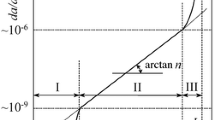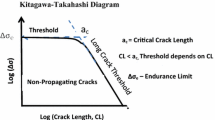Abstract
Our theory of fatigue crack growth, which is based on the Bilby, Cottrell, and Swinden crack theory, is modified to take into account work hardening at fatigue crack tips. In this analysis stress rather than cumulative displacement or cumulative damage is the quantity whose critical value controls the crack growth. The material at the tip of a fatigue crack progressively work hardens until the stress there reaches a critical value. The material then tears apart and the crack advances until it reaches a region in which the stress is smaller than the critical value. An equation which describes the growth of fatigue cracks is derived; it is essentially the same as the crack growth equation found in the earlier analysis. The major change is the replacement of the yield stress term in the older equation with an ultimate stress term in the newer equation. The chief change is the substitution for the average yield stress in the older equation with the ultimate stress in the present equation.
Résumé
La théorie sur la croissance des fissures de fatigue, développée par l'auteur sur la base de la théorie de la fissuration de Billy, Cottrel et Swinden, a été modifiée pour tenir compte de l'écrouissage à la pointe de la fissure de fatigue. Selon cette analyse, c'est davantage la tension que le déplacement cumulé ou le dommage cumulé qui est la grandeur dont une valeur critique régit la croissance de la fissure.
Le matériau à la pointe d'une fissure s'écrouit petit à petit jusqu'à ce que la tension atteigne en cet endroit une valeur critique. Le matériau est alors le siège d'une rupture par séparation et la fissuration progresse jusqu'à atteindre une région où la tension est plus faible que la valeur critique. La croissance des fissures de fatigue a été ainsi décrite par une équation, qui a essentiellement la même forme que celle qui a été établie précédemment. La principale différence réside dans le remplacement du terme “limite élastique” par un terme “charge de rupture” dans la nouvelle équation.
Zusammenfassung
Unsere Theorie über die Ausbreitung der Müdigkeitsriße, die sich auf die Rißbildungstheorie von Bilby, Cottrell und Swinden begründet, wurde umgeändert um das Härten durch Kaltverformung an der Spitze des Müdigkeitsrisses zu berücksichtigen.
In dieser Analyse ist eher die Spannung, als die summierte Fortbewegung oder der summierte Schaden, die Quantität deren kritischen Wert die Ausbreitung des Risses kontrolliert. Die Materie an der Spitze des Müdigkeitsrisses härtet sich nach und nach durch Kaltverformung bis die Spannung dort einen kritischen Wert erreicht. Das Material zerreißt sich dann und der Riß schreitet voran bis er eine Stelle erreicht wo die Spannung niedriger ist als der kritische Wert. Line Gleichung, die die Ausbreitung des Müdigkeitsrisses beschreibt wird abgeleitet und sie hat größtenteils die selbe Form wie die die früher aufgestellt wurde. Der Hauptunterschied liegt darin daß die Elastizitätsgrenze in der älteren Gleichung durch die Bruchspannung in der neuen Gleichung ersetzt wird.
Similar content being viewed by others
References
B. A. Bilby, A. H. Cottrell and K. H. Swinden, Proc. Roy. Soc. (London), 272A (1963) 304.
J. Weertman, Inter. J. Frac. Mech., 2 (1966) 460.
J. Weertman, Inter. J. Frac. Mech., 5 (1969) 13.
B. A. Bilby and P. T. Heald, Proc. Roy. Soc. (London), 305A (1968) 429.
L. N. McCartney and B. Gale, Proc. Roy. Soc. (London), 322A (1971) 223.
H. L. Marcus, P. N. LaMori, J. A. Horak, A. Arko, R. Hanada, S. K. Lahiri, A. S. Mehner, F. W. Wiffen and J. Weertman, Inter. J. Frac. Mech., 1 (1965) 156.
B. A. Bilby and J. D. Eshelby, Fracture, Vol. I, H. Liebowitz (ed.), Academic Press, New York, 99 (1968).
A. J. McEvilyJr. and T. L. Johnston, Proc. Int. Conf. on Fracture, Sendai, Japan, 2, (1966) 515.
A. S. Tetelman and A. J. McEvilyJr., Fracture of Structural Materials, Wiley, New York, (1967) 369.
E. Orowan, Proc. Roy. Soc. (London), 171A (1939) 79.
J. Weertman and J. R. Weertman, Physical Metallurgy, 2nd Edition, R. W. Cahn (ed.), North-Holland, Amsterdam, (1970) 921.
Author information
Authors and Affiliations
Additional information
Support by the U.S. Office of Naval Research Contract N00014-67-A-0356-0016.
Rights and permissions
About this article
Cite this article
Weertman, J. Theory of fatigue crack growth based on a BCS crack theory with work hardening. Int J Fract 9, 125–131 (1973). https://doi.org/10.1007/BF00041854
Received:
Issue Date:
DOI: https://doi.org/10.1007/BF00041854




